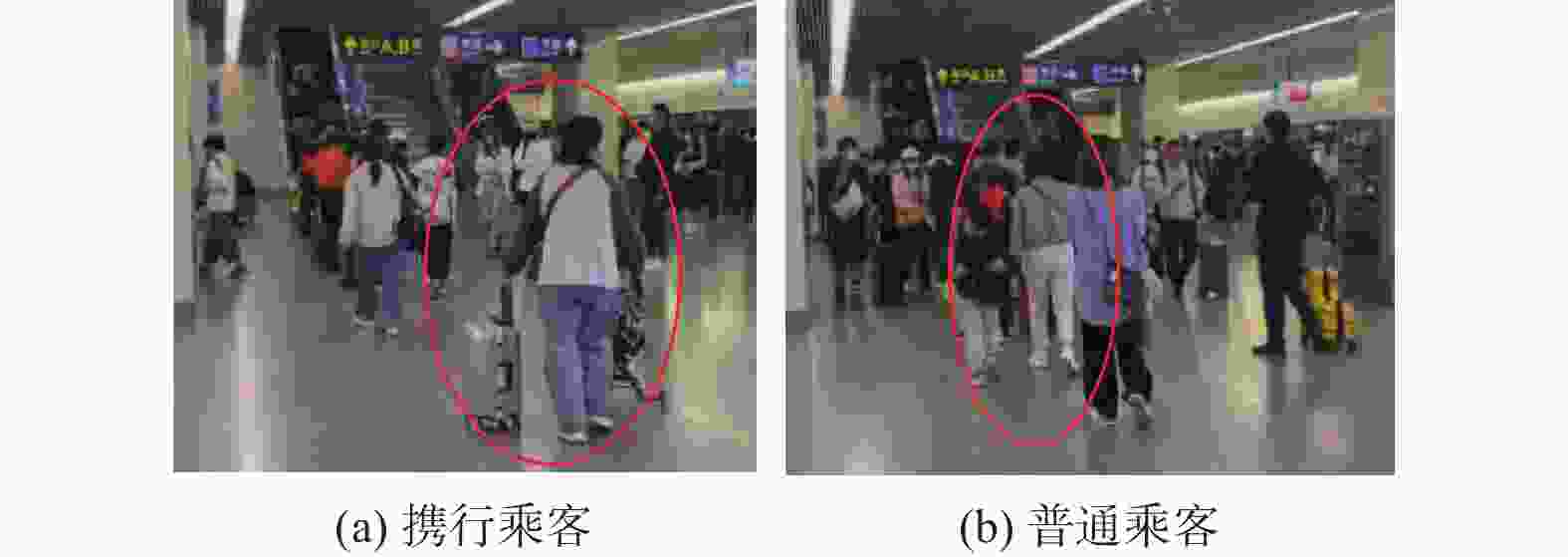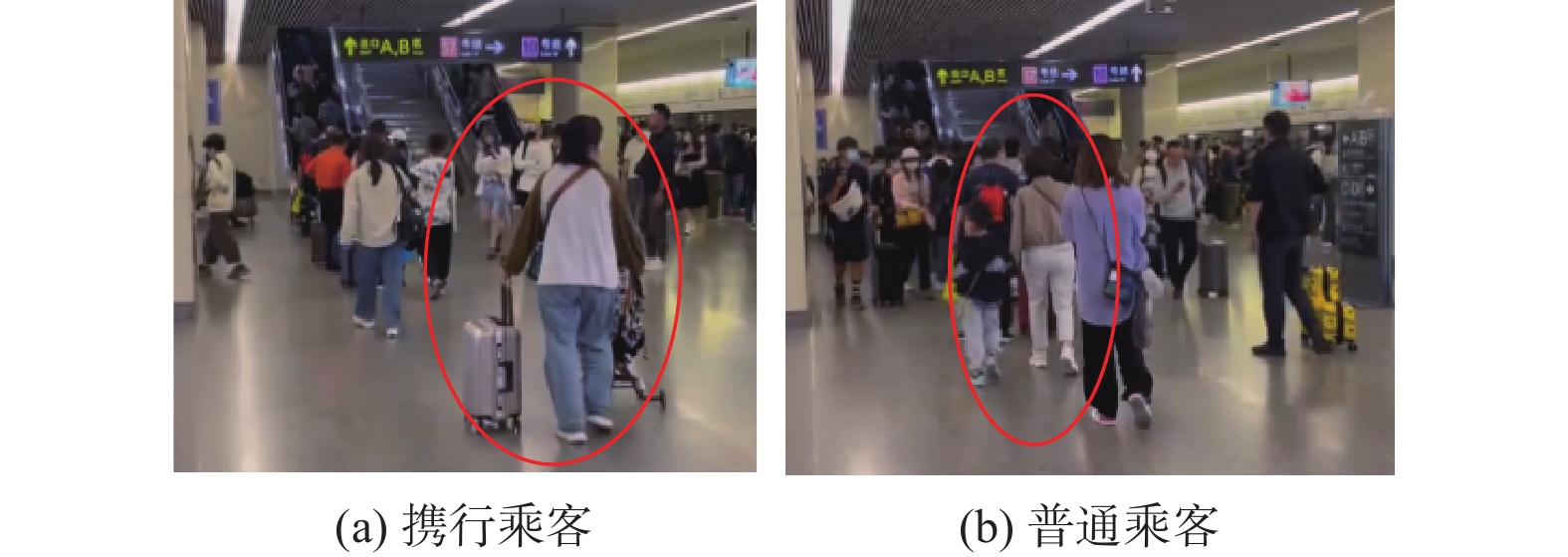Guiding strategy of stair and escalator passengers in metro hub stations considering urban resilient safety
-
摘要: 为解决轨道交通站台楼扶梯处因列车到站高密度客流导致的乘客拥挤等问题,建立了考虑体力和时间消耗的综合阻抗函数,提出最优楼扶梯选择建议。首先,采集到站列车各车门下车乘客数,结合Dijkstra算法实现乘客楼扶梯组分配;其次,计算楼扶梯处乘客排队参数;再次,构建乘客楼扶梯选择阻抗函数,结合排队特性得到不同乘客楼扶梯选择最优决策;最后,选取上海地铁2号线虹桥火车站地铁站进行实例分析。结果表明:当扶梯前排队等待时间为10.32 s时,建议普通乘客选择楼梯进行乘降;当扶梯前排队等待时间分别为29.91 s和40.31 s时,分别建议小件和大件携行乘客选择楼梯进行乘降作业。Abstract: To address issues related to passenger congestion at the stairs and escalators of the platforms resulting from the intense gathering of passenger flow upon the arrival of rail transit trains, the impedance function of the optimal decision selecting stair and escalator was constructed, which integrated both physical consumption and time consumption. Firstly, the number of passengers disembarking from each door of the arriving train were collected and Dijkstra's algorithm was utilized to allocate passengers to stair and escalator groups. Secondly, passenger queuing parameters at stairs and escalators were calculated. Thirdly, combined with the queuing characteristics, the impedance functions for stair and escalator selection were built, then the optimal decision of stair and escalator selection for different passengers were obtained. Finally, a case study of Hongqiao Railway Station of Shanghai Metro Line 2 was carried out. The results indicated that, when the waiting time in the queue before the escalator was 10.32 s, it was recommended for regular passengers to use the stairs; when the waiting time in the queue before the escalator increased to 29.91 and 40.31 s, it was advisable for passengers with luggage to use the stairs.
-
表 1 楼扶梯相关参数
Table 1. Stairs and escalators related parameters
参数 楼梯 扶梯 单次走行时间/s 普通乘客:27.79 28.36 小件携行乘客:30.42
大件携行乘客:32.86单阶高度/m 0.16 0.25 总高度/m 7.52 7.52 表 2 部分车门至各楼扶梯组的走行距离
Table 2. Walking distance from car doors to stairs and escalators
车门号 1号楼扶梯组/m 2号楼扶梯组/m 3号楼扶梯组/m 1号 45.0 84.5 131.5 2号 40.5 80.0 127.0 3号 36.0 75.5 122.5 4号 31.5 71.0 118.0 $\vdots $ $\vdots $ $\vdots $ $\vdots $ 39号 126.0 86.5 39.5 40号 130.5 91.0 44.0 表 3 各车门下车乘客数
Table 3. Passenger numbers getting off each door
车门号 乘客数 车门号 乘客数 车门号 乘客数 1号 5 15号 12 29号 10 2号 4 16号 9 30号 12 3号 8 17号 12 31号 10 4号 9 18号 11 32号 12 5号 9 19号 12 33号 11 6号 10 20号 9 34号 9 $\vdots $ $\vdots $ $\vdots $ $\vdots $ $\vdots $ $\vdots $ 12号 17 26号 14 40号 6 13号 13 27号 11 14号 12 28号 11 表 4 各楼扶梯组总乘客数及排队论参数
Table 4. Total number of passengers and queuing parameters of escalator groups in each building
楼扶梯组
编号总乘客数
/人平均服务率
/(人·min−1)平均到达率
/(人·min−1)平均队长
/人平均等待
时间/s1号 153 87 84.41 33 22.47 2号 107 87 84.66 36 24.95 3号 155 87 84.87 40 27.48 -
[1] 中华人民共和国住房和城乡建设部. 地铁设计规范: GB 50157—2013[S] . 北京: 中国建筑工业出版社, 2013. [2] 中华人民共和国住房和城乡建设部. 城市轨道交通技术规范: GB 50490—2009[S] . 北京: 中国建筑工业出版社, 2009. [3] 郑勋. 城市轨道交通车站乘客微观行为分析与建模[D] . 北京: 北京交通大学, 2019. [4] 张子琦. 城市轨道交通站点客流服务能力优化研究[D] . 南京: 东南大学, 2019. [5] 史芮嘉, 丁勇, 柏赟, 等. 地铁乘客对步行楼梯和自动扶梯的选择行为分析及建模[J] . 交通运输系统工程与信息, 2015, 15(1): 185 − 190. [6] JI X F, ZHANG J, RAN B. A study on pedestrian choice between stairway and escalator in the transfer station based on floor field cellular automata[J] . Physica A Statistical Mechanics & Its Applications, 2013, 392(20): 5089 − 5100. [7] 朱昌稳. 地铁车站通道行人楼扶梯选择及仿真模型研究[D] . 北京: 北京交通大学, 2018. [8] 渠静. 考虑携带行李人群的高铁车站行人运动建模研究[D] . 北京: 北京交通大学, 2022. [9] SHAH J, JOSHI G J, PARIDA P. Behavioral characteristics of pedestrian flow on stairway at railway station[J] . Procedia - Social and Behavioral Sciences, 2013, 104: 688 − 697. doi: 10.1016/j.sbspro.2013.11.163 [10] 金光浩, 刘小明, 边扬. 行人体力消耗量化方法及其应用研究[J] . 交通运输系统工程与信息,2013,13(3):157 − 162. [11] 王琨, 孙立山, 罗薇, 等. 基于网络瓶颈控制的轨道交通车站客流疏导研究[J] . 都市快轨交通, 2019, 32(3): 84 − 90, 101. [12] 何彬, 顾保南, 杨照. 城轨交通换乘站结点换乘设施行人拥堵分析方法[J] . 同济大学学报(自然科学版), 2020, 48(6): 861 − 868. -






 下载:
下载:





